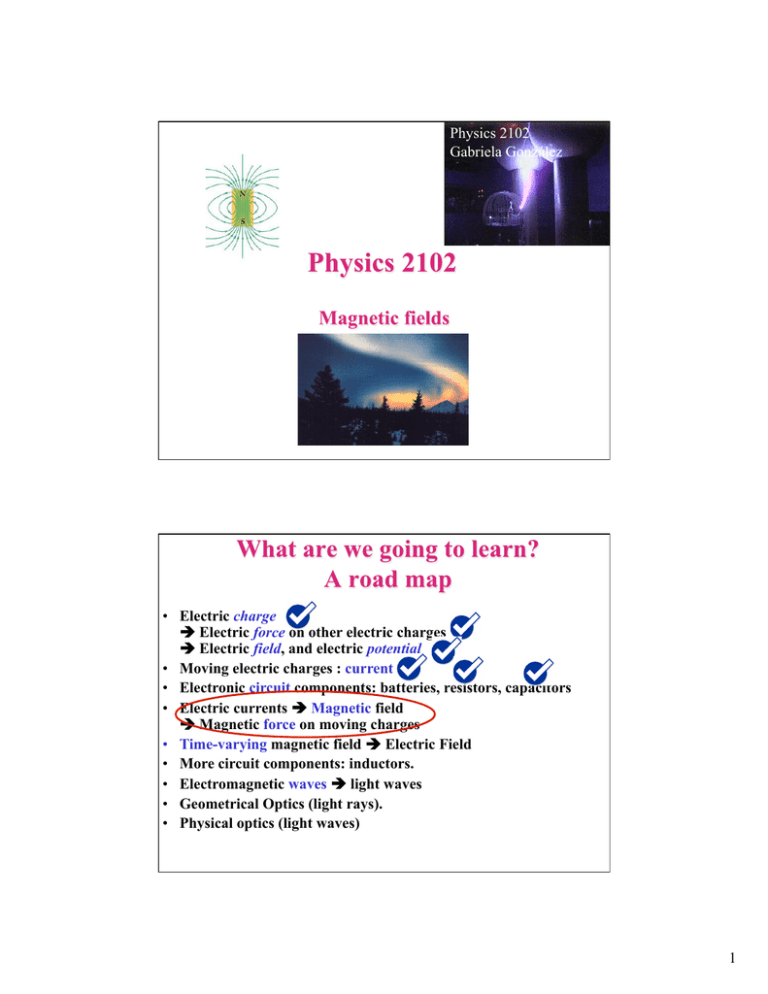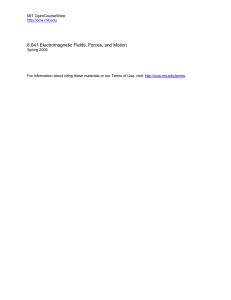1 Physics 2102 Gabriela González • Electric charge → Electric force
advertisement

Physics 2102 Gabriela González • Electric charge Electric force on other electric charges Electric field, and electric potential • Moving electric charges : current • Electronic circuit components: batteries, resistors, capacitors • Electric currents Magnetic field Magnetic force on moving charges • Time-varying magnetic field Electric Field • More circuit components: inductors. • Electromagnetic waves light waves • Geometrical Optics (light rays). • Physical optics (light waves) 1 • Electric charge • Electric force on other electric charges • Electric field, and electric potential • Moving electric charges : current • Electronic circuit components: batteries, resistors, capacitors • Electric currents • Magnetic field • Magnetic force on moving charges • Time-varying magnetic field • Electric Field • More circuit components: inductors • All together: Maxwell’s equations • Electromagnetic waves • Optical images • Matter waves We know that an electric field exists because it accelerates electric charges, with a force independent of the velocity of the charge, proportional to the electric charge: FE = qE We know that a magnetic field exists because it accelerates electric charges in a direction perpendicular to the velocity of the charge, with a magnitude proportional to the velocity of the charge and to the magnitude of the charge: FB= q v x B Magnetic forces are perpendicular to both the velocity of charges and to the magnetic field (electric forces are parallel to the field). Since magnetic forces are perpendicular to the velocity, they do no work! (W=F · r) Speed of particles moving in a magnetic field remains constant in magnitude, the direction changes. Kinetic energy is constant (no work). 2 Circular motion: v FB= q v x B Since magnetic force is transverse to motion, the natural movement of charges is circular. F B into blackboard. In general, path is a helix (component of v parallel to field is unchanged). The figure shows the path of a particle through six regions of uniform magnetic field, where the path is either a half circle or a quarter circle. Upon leaving the last region, the particle travels between two charged parallel plates and is deflected towards the plate of higher potential. What are the directions of the magnetic fields in each region? +V Electric force is opposite to the electric field: the charge v must be negative! E x -V F 3 Aurora borealis (northern lights) Synchrotron Suppose you wish to accelerate charged Fermilab, Batavia, IL (1km) particles as fast as you can. Linear accelerator (long). Large Hadron Collider (CERN) 27km circumference Wikipedia: This synchrotron is designed to collide opposing particle beams of either protons at an energy of 7 teraelectronvolts per particle, or lead nuclei at an energy of 574 TeV per nucleus. On 30 March 2010, the first planned collisions took place between two 3.5 TeV beams, which set a new world record for the highest-energy manmade particle collisions. http://angelsanddemons.cern.ch/ 4 Two charged ions A and B traveling with a constant velocity v enter a box in which there is a uniform magnetic field directed out of the page. The subsequent paths are as shown. What can you conclude? (a) Both ions are negatively charged. A v B (b) Ion A has a larger mass than B. v (c) Ion A has a larger charge than B. (d) None of the above. FB= q v x B (a) F=qv x B. The vector v x B will point down when the charges enter the box; the force also points down for cw motion: charges must be positive. (b,c) r= mv/qB Same speed and B for both masses; larger radius for A than B. Ion with larger mass/charge ratio (m/q) moves in circle of larger radius. But that’s all we know! We cannot conclude b or c. (d) Is the right answer. The figure shows four directions for the velocity vector v of a positively charged particle moving through a uniform electric field E (out of the page) and a uniform magnetic field B. • Rank directions 1, 2, 3 according to the magnitude of the net force on the particle. • If the net force is zero, what is the direction and magnitude of the particle’s velocity? 5 A solid metal cube moves with constant velocity v in the ydirection. There is a uniform magnetic field B in the zdirection. • What is the direction of the magnetic force on the electrons in the cube? • What is the direction of the electric field established by the electrons that moved due to the magnetic force? • Which cube face is at a lower electric potential due to the motion through the field? • What is the direction of the electric force on the electrons inside the cube? • If there is a balance between electric and magnetic forces, what is the potential difference between the cube faces (in terms of the cube’s velocity v, side length d and magnetic field B)? Cathode ray tube (CRT) : TV, computer monitors before LCD Hot cathode emits electrons Get accelerated by positive plate Might be deflected using plates Produce point of light on screen. In a magnetic field: B v Fe Dot shifts sideways. http://en.wikipedia.org/wiki/Comparison_of_display_technology 6


